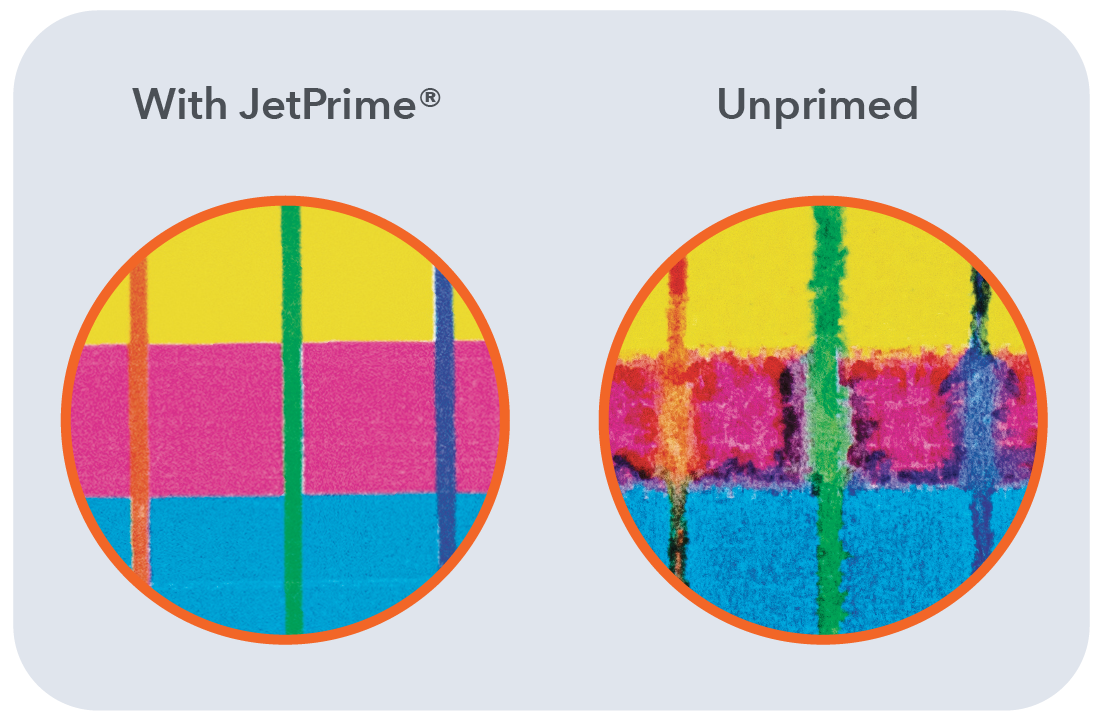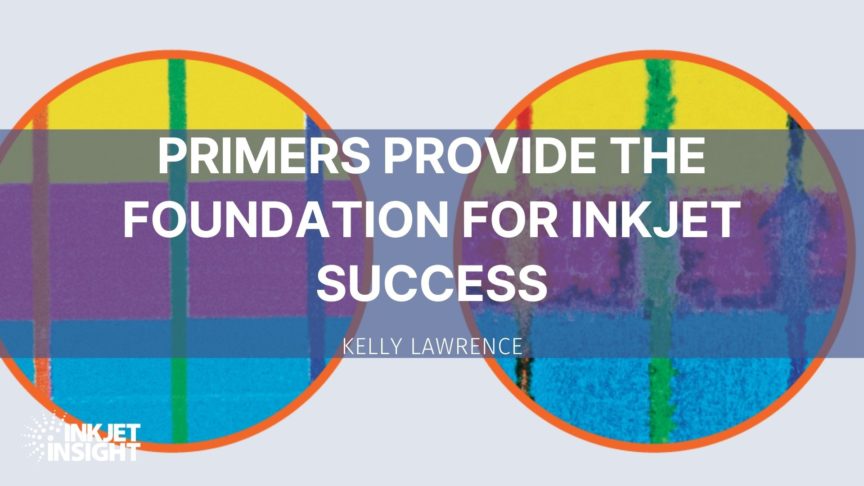Sponsored by Michelman
As inkjet continues to grow, how can OEMs accelerate the learning curve for their customers, ensure quality prints, boost ROI, and accelerate adoption of inkjet in new applications? In a previous article, we discussed how the substrate or print media contributes significantly to inkjet printing success. In this article, we dig deeper into how primers impact media quality and inkjet printing results.
The Purpose and Potential of Primers
A primer is a coating that is applied to a substrate to bridge performance between the substrate itself and the ink that is printed on it. A primer is a very thin fluid that ensures the colorants stay in place so the printed media delivers the expected color and print quality. As is the case with offset and flexo printing, inkjet primers can significantly reduce ink bleed and coalescence.
A good primer keeps the ink on the surface, minimizing the amount of ink that has to be used in order to get a great print while promoting adhesion to the substrate and enhancing print longevity. Some “inkjet formulated” substrates may come ready-to-print with primers pre-applied by a media supplier. However, primers are often applied to offset stocks and other substrates by the end user as either an inline or nearline process.

Inkjet print defects on different substrate types that can be solved with the use of a primer
A properly primed substrate impacts print quality, color, gloss, print protection and other finishing, and overall productivity. In the early days of inkjet, one could argue that the lack of compatible substrate availability limited widespread use, and therefore OEM growth. This spurred some OEMs to develop their own primers in order to broaden substrate availability and expand market adoption.
At that time, OEMs developed their own primers out of necessity to serve their primary application segments. That was ok to start with, but new applications segments required more variations in ink as well as primer. As OEM’s existing customers expanded into new applications and OEMs pursued new customers in application segments such as packaging, modifications were needed to further optimize the primer for each new application and relevant substrate. Creating the right primer for each scenario significantly expanded R&D requirements.
While developing the “right”, application-tuned primer takes work, using the wrong primer can cause print quality problems and increase costs in many ways. For example, primers should be designed so they do not corrode the application equipment and lead to repairs and equipment downtime. Corroded equipment can be an indicator of poor primer design.
When a primer is designed correctly and specifically for the target application, it will work seamlessly with the substrate and ink of choice. The primer will deliver the desired print quality, color, and gloss without causing any negative implications on the application equipment, finishing processes e.g. die cutting or on any additional post-coatings such as overprint varnishes (OPVs).

This illustration shows the layers of primer treated media. The primer is a thin layer that immobilizes the pigments resulting in the expected print quality and improved ink efficiency
Primer Technology: Why Inkjet and Analog Primers are Different
Inkjet and analog printing are very different processes. Primers are used with aqueous pigment inkjet inks which contain more liquid and have a lower solids content than do off-set or flexo pigment inks. Inkjet water-based pigment inks are fluid, whereas analog inks are more like a paste.
The task of a primer for water-based inkjet is to immobilize the colorants/pigments on the surface of the substrate. The fluid is then evaporated off the surface with the help of dryers. This is especially important on a non-porous substrate like a film. Not using a primer on a non-porous film results is a blurry print that can easily be wiped off.

The primed inkjet substrate delivers a higher print quality than the unprimed inkjet substrate. Notice the unprimed substrate appears blurry while the primed substrate virtually eliminates ink bleed.
Inkjet primers deliver the same benefits as offset and flexo print primers. They affect image quality, bleed, coalescence, performance at speed, application equipment life (no corrosion) and media appearance. A primer supplier must take all these factors into account when designing a primer for a given application that is optimized with the OEM equipment and ink. The supplier should also take health, safety and environmental considerations into account for each application segment served. For example, primer formulation will be different for an application that requires FDA direct food contact compliance versus one that will not.
Substrate Challenges to Inkjet Growth in Packaging
While inkjet is expected to grow in packaging applications, the lack of optimized media has the potential to hold back adoption. One substrate with one primer will not fit all applications. Inkjet has come a long way since the days of desktop printers. There are now bigger and faster printers as well as numerous applications to accommodate. To deliver the double digit CAGRs predicted by the Smithers report The Future of Digital Print for Packaging to 2026, OEMs need to ensure end users have access to the right substrates. This includes access to the right primers and overprint varnishes to achieve desired print and application performance.
Developing the right substrates for inkjet printed packaging is a challenge. As noted in the article “Moving Inkjet Forward,” packaging and label applications use a wide variety of synthetic and fiber-based substrates with diverse surfaces ranging from non-porous to very porous. OEMs must find the right combination of substrate, printhead, ink, and drying for each unique press. Each component decision impacts the other. For example, each type of ink will require variations in the drying process based on the target substrate. These factors may affect the characteristics of any fluid used in the print system.
If you consider these many requirements as variables in a matrix, there are a daunting number of combinations that must work together. It is often more efficient for these variables, as they relate to primer development, to be managed by a specialist primer developer. Close partnership between OEMs and their primer development partners is necessary to ensure the final chemistry addresses all of these aspects.
Additional opportunity lies in helping OEMs and end users understand that properly primed media can positively impact the total cost of ownership. While the primer solution is an additional expense and the application represents cost and process complexity, there are many other expenses to consider as well. One benefit is the ability to utilize lower cost media that may already be in a print providers inventory. In addition to avoiding additional expense, the sourcing of new inkjet media from a paper supplier increases the time to complete the print job and adds risk if the resulting print quality does not meet criteria specified by the print buyer. The largest opportunity is the utilization of the press. Consistent operation of primer fluids for the benefit of low maintenance and reliable performance allows the press owner to fill capacity with the range of print opportunities available.
Building Bridges: OEM Primer Expert Collaboration
A primer is the bridge between ink and substrate that enables optimal performance. OEMs can work with their primer partners to build better bridges that deliver desired performance levels for each target application. This includes improving the ROI of the inkjet system over time. Downstream process considerations are critical in primer design. As an example, Michelman primers are designed for either inline or nearline application at the press. Inline and nearline priming creates value for the print shop. “Bringing the primer to the press, gives printers more control over their total cost of ownership,” says Susan Bailey, Business Development Manager, Digital and Specialty Printing with Michelman. “When primers are applied in-line or near line to the press, the print shop decides how the primers are used. The reality is that some applications are more forgiving than others. The printer can decide how they use a specialized primer to optimize print and application performance.”
Alternatively, printers could outsource priming, sometimes called offline priming. Offline priming is performed at a different location and requires additional shipping costs to get the substrate to the print shop for printing following primer application. Given shipping cost increases over the last two years, inline and nearline primer application significantly reduce the cost of the inkjet-ready media.
OEMs also stand to benefit from inline or nearline priming at the press. Because the print system is in one location, the OEM gains visibility to what the print shop is doing and what the print shop wants to achieve. OEMs are then in a better position to make fluid recommendations. This visibility helps OEMs ensure the right fluids are used for the right application and that fluids used are consistent with equipment warranty expectations. “OEMs that partner with the print shop and the primer supplier have the best position to make recommendations. When OEMs make good recommendations, they accelerate the adoption of inkjet in their targeted applications,” notes Bailey.
Primers: The Bridge to Widespread Inkjet Adoption
Primers have the potential to be a bridge to desired performance in new inkjet applications like packaging. Accelerated end user success is likely to mean accelerated market penetration for inkjet OEMs. With global supply chain challenges that have heightened with political uncertainties, it is critical OEMs establish the right supply chain partnerships to facilitate substrate compatibility and support inkjet growth in new applications.
Editor’s Note: To learn more about the impact of priming and coating fluids on enhancing inkjet quality and compatibility, register now for “Understanding Priming and Coating for Inkjet” with Mary Schilling and Elizabeth Gooding on Tuesday April 26 at 1 pm ET.

